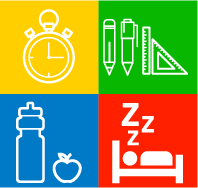21 Plan for Exams
Leave yourself enough time to study. Practise answer questions. Get enough sleep, liquids and food so you can be alert and ready.

Answer all your exam questions
“I know the material but I can’t figure out how to answer the question!” – most students, sometimes
Here are a few ideas on how to get the material that you have studied down on the exam paper when you are under the stress of writing with limited time.
Read All Questions Carefully!
Manage Your Time!
Short Answer Questions
Your instructor is looking for a brief and descriptive answer.
- Allocate your time according to the proportion of marks each question is worth.
- Use questions that ask for definitions or explanations to inform the longer, more explanatory part of your answer. Don’t repeat the information you give in one part of the question in the other.
- If a question that asks you to “explain”, imagine you are telling a friend about the topic.
- If you have questions which are a mix of short and essay answers, check the rubric carefully so you don’t miss answering part of the question.
Essay Questions
Here you will discuss and expand on a topic and write several paragraphs.
- Think about what the question is actually asking. What are you expected to include in your answer? What material will be relevant? The most common complaint from markers is that the student didn’t answer the question.
- If a question asks you to “briefly comment”, treat it as a mini-essay – have a sentence or two to introduce your topic; select a few points to discuss with a sentence or two about each; add a concluding sentence that sums up your overall view.
Make a Plan! Take a few minutes to think and plan:
- Underline the key words in the question.
- Identify the main topic and discussion areas.
- Choose a few points/arguments about which you can write.
- Make a mini-plan which puts them in order before you start writing. You can cross it through afterwards.
Demonstrate that you are answering the question – In your introduction show how you understand the question and outline how you will answer it. Make one point or argument per paragraph and summarize to show how it answers the question. Paragraphs with one or two pieces of evidence are sufficient. In your conclusion summarize the arguments to answer the question.
Multiple Choice Questions
Multiple choice exams ask you to recognize a correct answer among a set of options that include three or four wrong answers (called distracters). Some consider these easier because the correct answer is guaranteed to be in the possible responses.
Read each question carefully.
Multiple choice exams also examine your ability to read carefully and thoughtfully, as much as they test your ability to recall and reason. You must answer the question that is being asked.
Start with questions you feel most comfortable answering.
- Cover up the choices with a piece of paper while you read the stem, or body of the question. Decide what you think the answer is.
- Then uncover the answers and pick the one that matches your answer. Check to be sure that none of the other responses is better.
- Read the question and treat each option as a true-false question. Choose the most true.
- If you are unable to make a choice, or you answered the question but are unsure that it is correct, put a question mark beside that question, and move on to the next.
- Move on and finish all of those questions that you can answer and then to come back later to process the problematic questions.
- Sometimes the answer will occur to you simply because you are more relaxed after having answered other questions.
If you can’t decide on an answer:
- Absolute words, such as “always” or “never” are less likely to be correct than conditional words like “usually” or “probably.” “Funny” or “strange” options are often wrong.
- If you can verify that more than one of the responses are probably correct, then “all of the above” may be a correct response.
- “None of the above” is often an incorrect response, but not always. Check the options.
- Be very careful of double negatives. Create the equivalent positive statement.
- Eliminate options you know to be incorrect.
- If all else fails…guess (unless there is a penalty for wrong answers).
Finally: Take the time to check your work before you hand it in.
Math Problem Questions
Word problem questions ask you to analyze a math problem and pick the right elements to use your math.
- Think about what the question is actually asking you to find out. This is the goal.
- What are you expected to include in your answer? What figures will be relevant? What figures do not matter?
- Underline the key words in the question and identify the main idea and information given.
- Make a mini-plan which identified the formulas that you are going to use before you start.
What to do if your mind goes blank?
Put your pen down, take a deep breath, sit back and relax for a moment. If you’re in the middle of an answer, read through what you have written so far – what happens next? If you really can’t progress with this answer, leave a gap. It will probably come back to you once you are less anxious.

